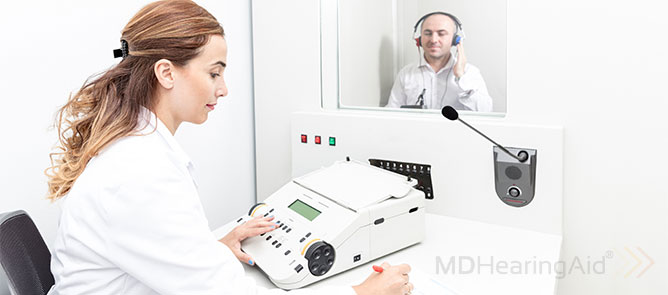People suffer from hearing problems now more than ever, often due to genetics, aging, injuries, medications, or disease. Since the pandemic, hearing loss has been linked to COVID-19. Since there are many different types of hearing loss, the best way to determine what type you or a loved one has is through hearing tests.
Gone are the days of relying on tuning forks to identify hearing loss. Technological advances and reliable internet connections provide more accurate, convenient ways for people to get their ears checked. In particular, the audiometer is an essential medical device in hearing health.
If you don't know what an audiometer is, keep reading. This article answers the common question, "What is an audiometer?" You'll also learn how it's used, how much they cost, and who regulates them. Most importantly, we identify where it fits in with your hearing.
What is an audiometer?
An audiometer is a medical device used to test your hearing. Audiometers are regulated by the Food and Drug Administration (FDA) and American National Standards Institute (ANSI).
The Food and Drug Administration (FDA) defines an audiometer as "an electroacoustic device that produces controlled levels of test tones and signals intended for use in conducting diagnostic hearing evaluations and assisting in the diagnosis of possible otologic disorders."
An audiometer is an electric tool that contains several parts, including:
- Sound generator
- Oscillator
- Attenuator
- Microphone
- Earphones
Audiometers range in price from as little as $750 to more than $6000 per unit. The differences vary widely as some can be used alone, whereas others can connect to a computer.
What is an audiometer used for?
An audiometer is classified as a medical diagnostic device under the ear, nose, and throat category. It can be used for several different types of hearing tests, and is typically used in a hearing clinic.
Pure Tone Audiometry
This test is one that most people are familiar with. It involves wearing a set of headphones connected to an audiometer. As you wear the headphones, pure tones are sent to your ears. The tones will vary in frequency/pitch, measured in hertz (Hz), and intensity/loudness, measured in decibels (dB). Each ear gets tested individually.
During a pure-tone test, you'll be instructed to raise your hand, press a button, or signal when you hear a tone. The results of your test are placed on a graph along with the minimum thresholds for normal hearing levels. This is known as an audiogram and is used to graphically represent hearing loss on a defined scale.
Bone Conduction Audiometry
In addition to measuring tones, an audiometer can determine how well the cochlea functions. A device called a bone oscillator is placed on the forehead or behind the ear, usually as a headband.
Sounds are sent through the oscillator, causing the bones in the skull to vibrate. This bypasses the middle and outer ear to directly stimulate the cochlea, the spiral cavity in the inner ear. Both air and bone conduction testing are done to determine if someone has conductive hearing loss or sensorineural hearing loss.
Speech Audiometry
Speech audiometry tests how well you can hear speech. You'll wear a headset through which words are spoken at different volumes. You're tested on the ability to hear, understand, and repeat those words. This is measured as the speech reception threshold (SRT), which is the lowest level in decibels that you can repeat half of the words correctly. In addition, you’ll be assigned a word recognition score (WRS), the number of correctly repeated words out of the number of presented words.
There are other audiometry tests and word recognition tests, but these are the most commonly used types. Depending on the suspected hearing issue, hearing specialists may perform these tests separately or in one session.
Who uses audiometers?
Audiometers are used by medical hearing professionals specially trained in conducting hearing tests. In accordance with the Occupational Safety and Health Administration (OSHA), all testers must qualify as a technician: "Audiometric tests shall be performed by a licensed or certified audiologist, otolaryngologist, or other physicians, or by a technician who is certified by the Council [for] Accreditation in Occupational Hearing Conservation, or who has satisfactorily demonstrated competence in administering audiometric examinations, obtaining valid audiograms, and properly using, maintaining and checking calibration and proper functioning of the audiometers being used. A technician who performs audiometric tests must be responsible to an audiologist, otolaryngologist or physician."
A technician can be trained to conduct audiometric hearing tests by completing a training course offered by the Council for Accreditation in Occupational Hearing Conservation (CAOHC) or other recognized organizations. In other cases, a healthcare worker may gain on-the-job training and demonstrate they can conduct the testing. Technicians must be able to properly use, maintain, calibrate, and perform other functions for the type of audiometer they'll be using.
Teleaudiology
Recent approaches in teleaudiology empower patients to take charge of their hearing testing. This is done through audiometry equipment that has been adapted for home use. The audiometer is shipped to the patient and a licensed hearing specialist conducts the hearing test via video-conferencing.
You may wonder if there's a difference between having your ears tested in-person versus remotely. It doesn't really matter—base it on your preference—as both methods provide the results you need, as long as you have the necessary equipment. In fact, a study published in the International Journal of Audiology in March 2022 proved that remote audiometry tests are as accurate as in-person audiometry tests when using remote calibrated bone/air conduction equipment. Based on a review of other studies, teleaudiology provides four key benefits: improved access, cost-effectiveness, improved quality, and patient demand.
Treating hearing loss with hearing aids
If your audiometry test shows a hearing loss, hearing aids might be an excellent solution. You can even order them through the internet, so be sure to check out our guide on how to buy hearing aids online.
Don't let cost stop you from exploring your options. Hearing aids have a reputation for being very expensive and are usually not covered by insurance. While many are too expensive for most people, there are much more affordable high-quality brands available now, particularly those you can find online.
At MDHearing, we develop high-quality, FDA-registered hearing aids to help people improve their quality of life at budget-friendly prices. Our team of licensed audiologists and hearing specialists are here to answer your questions about hearing loss and help you decide if our hearing aids will work for you.
Want to learn more about our FDA-registered hearing aid options?
BROWSE HEARING AIDS

